
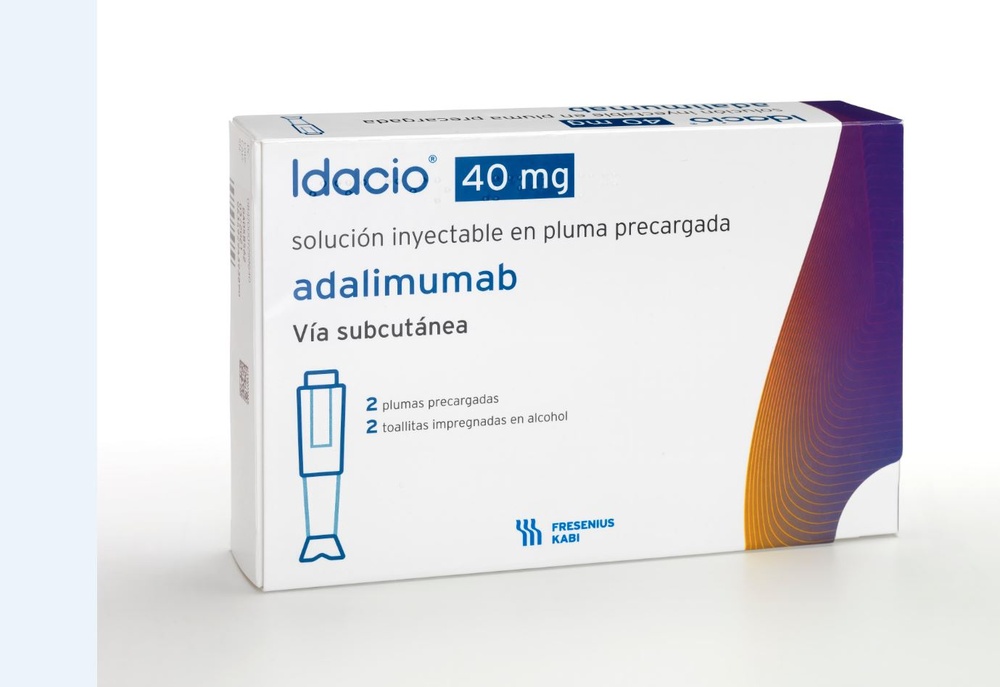
IDACIO 40 mg SOLUTION FOR INJECTION IN PRE-FILLED PEN


How to use IDACIO 40 mg SOLUTION FOR INJECTION IN PRE-FILLED PEN
Introduction
Package Leaflet: Information for the Patient
Idacio 40 mg solution for injection in pre-filled pen
adalimumab
Read all of this leaflet carefully before you start using this medicine because it contains important information for you.
- Keep this leaflet, you may need to read it again.
- Your doctor will give you a patient information card, which contains important safety information that you need to know before and during treatment with Idacio.
Keep this patient information card during your treatment and for 4 months after your last injection (or your child's) of Idacio.
- If you have any further questions, ask your doctor or pharmacist.
- This medicine has been prescribed for you only. Do not pass it on to others. It may harm them, even if their signs of illness are the same as yours.
- If you get any side effects, talk to your doctor or pharmacist. This includes any possible side effects not listed in this leaflet. See section 4.
Contents of the pack
- What is Idacio and what is it used for
- What you need to know before you use Idacio
- How to use Idacio
- Possible side effects
- Storing Idacio
- Contents of the pack and other information
- Instructions for use
1. What is Idacio and what is it used for
Idacio contains the active substance adalimumab, a medicine that works on the immune system (defence) of your body.
Idacio is used to treat the following inflammatory diseases:
- rheumatoid arthritis,
- juvenile idiopathic polyarticular arthritis,
- enthesitis-related arthritis,
- ankylosing spondylitis,
- axial spondyloarthritis without radiographic evidence of ankylosing spondylitis,
- psoriatic arthritis,
- psoriasis,
- hidradenitis suppurativa,
- Crohn's disease,
- ulcerative colitis, and
- non-infectious uveitis.
The active substance of Idacio, adalimumab, is a monoclonal antibody. Monoclonal antibodies are proteins that target a specific target in the body.
The target of adalimumab is another protein called tumour necrosis factor (TNFα), which is found in high levels in the inflammatory diseases described above. By targeting TNFα, Idacio blocks its action and reduces the inflammation process in these diseases.
Rheumatoid Arthritis
Rheumatoid arthritis is an inflammatory disease of the joints.
Idacio is used to treat rheumatoid arthritis in adults. If you have moderate to severe active rheumatoid arthritis, you may have been given other medicines that modify the disease, such as methotrexate, before. If the effect of these medicines is not sufficient, you will be given Idacio to treat your rheumatoid arthritis.
Idacio may also be used to treat severe, active, and progressive rheumatoid arthritis without prior treatment with methotrexate.
Idacio can reduce the damage to the cartilage and bones of the joints caused by the disease and improve physical function.
Idacio is usually used in combination with methotrexate. If your doctor considers that methotrexate is not appropriate, Idacio may be given alone.
Juvenile Idiopathic Polyarticular Arthritis and Enthesitis-Related Arthritis
Juvenile idiopathic polyarticular arthritis and enthesitis-related arthritis are inflammatory diseases of the joints that usually appear for the first time in childhood.
Idacio is used to treat juvenile idiopathic polyarticular arthritis in children and adolescents from 2 to 17 years of age and enthesitis-related arthritis in children from 6 to 17 years of age. Patients may have received other disease-modifying medicines, such as methotrexate, before. If the effect of these medicines is not sufficient, patients will receive Idacio to treat their juvenile idiopathic polyarticular arthritis or enthesitis-related arthritis.
Ankylosing Spondylitis and Axial Spondyloarthritis without Radiographic Evidence of Ankylosing Spondylitis
Ankylosing spondylitis and axial spondyloarthritis without radiographic evidence of ankylosing spondylitis are inflammatory diseases that affect the spine.
Idacio is used in adults to treat these diseases. If you have ankylosing spondylitis or axial spondyloarthritis without radiographic evidence of ankylosing spondylitis, you will be treated first with other medicines. If the effect of these medicines is not sufficient, you will receive Idacio to reduce the signs and symptoms of your disease.
Psoriatic Arthritis
Psoriatic arthritis is an inflammatory disease of the joints associated with psoriasis.
Idacio is used to treat psoriatic arthritis in adults. Idacio can reduce the joint damage caused by the disease in the cartilage and bone and improve physical function.
Plaque Psoriasis in Adults and Children
Plaque psoriasis is an inflammatory disease of the skin that causes red, scaly, crusty, and silvery-scaled areas. Plaque psoriasis can also affect the nails, causing them to deteriorate, thicken, and lift off the nail bed, which can be painful. It is believed that psoriasis is caused by a defect in the body's immune system that leads to an increase in the production of skin cells.
Idacio is used to treat moderate to severe plaque psoriasis in adults. Idacio is also used to treat severe plaque psoriasis in children and adolescents from 4 to 17 years of age who have not responded or are not suitable for topical medicines or ultraviolet light treatment.
Hidradenitis Suppurativa in Adults and Adolescents
Hidradenitis suppurativa (also known as inverse acne) is a long-term and often painful inflammatory disease of the skin. Symptoms can include painful nodules (lumps) and abscesses (boils) that can secrete pus. It usually affects specific areas of the skin, such as under the breast, armpits, inner thighs, groin, and buttocks. There may also be scarring in the affected areas.
Idacio is used to treat hidradenitis suppurativa in adults and adolescents from 12 years of age. Idacio can reduce the number of nodules and abscesses and the pain associated with this disease. You may have received other medicines before. If the effect of these medicines is not sufficient, you will receive Idacio.
Crohn's Disease in Adults and Children
Crohn's disease is an inflammatory disease of the intestine.
Idacio is used to treat Crohn's disease in adults and children from 6 to 17 years of age. If you have Crohn's disease, you will be treated first with other medicines. If you do not respond sufficiently to these medicines, you will receive Idacio to reduce the signs and symptoms of Crohn's disease.
Ulcerative Colitis in Adults and Children
Ulcerative colitis is an inflammatory disease of the large intestine.
Idacio is used to treat moderate to severe ulcerative colitis in adults and children from 6 to 17 years of age. If you have ulcerative colitis, you may be given other medicines first. If the effect of these medicines is not sufficient, you will be given Idacio to reduce the signs and symptoms of your disease.
Non-Infectious Uveitis in Adults and Children
Non-infectious uveitis is an inflammatory disease that affects certain parts of the eye.
- Adults with non-infectious uveitis with inflammation that affects the back of the eye.
- Children from 2 years of age with chronic non-infectious uveitis with inflammation that affects the front of the eye.
The inflammation can lead to a decrease in vision and/or the presence of floaters in the eye (black dots or thin lines that move across the field of vision). Idacio works by reducing this inflammation.
Idacio is used to treat:
- adults with non-infectious uveitis with inflammation that affects the back of the eye.
- children from 2 years of age with chronic non-infectious uveitis with inflammation that affects the front of the eye.
2. What you need to know before you start using Idacio
Do not use Idacio
- if you are allergic to adalimumab or to any of the other components of this medicine (listed in section 6).
- if you have a severe infection, including tuberculosis, sepsis (blood infection), or other opportunistic infections (unusual infections associated with a weakened immune system). If you have symptoms of any infection, such as fever, wounds, fatigue, or dental problems, it is essential that you inform your doctor (see "Warnings and precautions").
- if you have moderate or severe heart failure. It is essential that you tell your doctor if you have had or have any serious heart problems (see "Warnings and precautions").
Warnings and precautions
Consult your doctor or pharmacist before starting to use Idacio.
Allergic reaction
- If you experience an allergic reaction with symptoms such as chest tightness, difficulty breathing, dizziness, swelling, or rash, discontinue the administration of Idacio and contact your doctor immediately, as these reactions can be life-threatening in rare cases.
Infection
- If you have any infection, including chronic or localized infections (e.g., a leg ulcer), consult your doctor before starting treatment with Idacio. If you are unsure, contact your doctor.
- With Idacio treatment, you may be more likely to get infections. This risk may be higher if you have reduced lung function. These infections can be more severe and include tuberculosis, viral, fungal, parasitic, or bacterial infections, or other unusual infectious organisms, and sepsis (blood infection). In rare cases, these infections can be life-threatening. Therefore, it is essential that if you have symptoms such as fever, wounds, fatigue, or dental problems, you inform your doctor. Your doctor may recommend that you temporarily discontinue treatment with Idacio.
Tuberculosis (TB)
- Since cases of tuberculosis have been reported in patients treated with Idacio, your doctor will examine you for signs or symptoms of tuberculosis before starting your treatment with Idacio. This will include a thorough medical evaluation, including your medical history and diagnostic tests (e.g., chest X-ray and tuberculin test). The performance and results of these tests should be recorded on your patient information card. It is crucial that you inform your doctor if you have had tuberculosis or have been in contact with a tuberculosis patient. Tuberculosis can develop during treatment, even if you have received preventive treatment for tuberculosis. If symptoms of tuberculosis (persistent cough, weight loss, general malaise, low-grade fever) or any other infection appear during or after treatment, contact your doctor immediately.
Travel/recurring infection
- Inform your doctor if you have lived or traveled to regions where fungal infections such as histoplasmosis, coccidioidomycosis, or blastomycosis are common.
- Inform your doctor if you have a history of recurring infections or other conditions or factors that increase the risk of infections.
Hepatitis B virus
- Inform your doctor if you are a carrier of the hepatitis B virus (HBV), if you have an active HBV infection, or if you think you may be at risk of contracting HBV. Your doctor should perform an HBV test. Adalimumab may reactivate HBV infection in people carrying this virus. In rare cases, especially if you are taking other medications that suppress the immune system, reactivation of HBV infection can be life-threatening.
Patient over 65 years old
- If you are over 65 years old, you may be more susceptible to infections while being treated with Idacio. Both you and your doctor should pay special attention to the appearance of signs of infection while being treated with Idacio. It is essential that you inform your doctor if you have symptoms of infections, such as fever, wounds, feeling of fatigue, or dental problems.
Surgical or dental interventions
- If you are going to undergo surgery or dental procedures, inform your doctor that you are using Idacio. Your doctor may recommend that you temporarily discontinue treatment with Idacio.
Demyelinating disease
- If you have or develop a demyelinating disease (a disease that affects the insulating layer surrounding nerves, such as multiple sclerosis), your doctor will decide whether you should be treated or continue treatment with Idacio. Inform your doctor immediately if you experience symptoms such as changes in vision, weakness in arms or legs, or numbness or tingling in any part of the body.
Vaccines
- Certain vaccines contain live, attenuated forms of bacteria or viruses that cause diseases and should not be administered during treatment with Idacio if these vaccines can cause infections. Consult your doctor before administering any type of vaccine. If possible, it is recommended that children receive all established vaccinations for their age before starting treatment with Idacio. If you receive Idacio while pregnant, your child may have a higher risk of developing infections during the 5 months following the last dose of Idacio you received during pregnancy. It is essential that you inform your child's doctor and other healthcare professionals about your use of Idacio during pregnancy, so they can decide whether your child should receive any vaccine.
Heart failure
- It is essential that you inform your doctor if you have had or have serious heart problems. If you have mild heart failure and are being treated with Idacio, your doctor should continuously monitor your heart failure. If new symptoms of heart failure appear or existing ones worsen (e.g., difficulty breathing or swelling of the feet), you should contact your doctor immediately.
Fever, bruising, bleeding, or pale appearance
- In some patients, the body may be unable to produce a sufficient number of the type of blood cells that fight infections (white blood cells) or those that help stop bleeding (platelets). If you have persistent fever, or suffer from bruising or bleeding easily, or are very pale, consult your doctor immediately. Your doctor may decide to discontinue treatment.
Cancer
- In very rare cases, certain types of cancer have been reported in children and adults treated with adalimumab or other TNFα blockers. People with more severe rheumatoid arthritis and those who have had the disease for a long time may have a higher-than-average risk of developing lymphoma and leukemia (cancers that affect blood cells and bone marrow). If you are being treated with Idacio, the risk of developing lymphoma, leukemia, and other types of cancer may increase. A specific and severe type of lymphoma has been observed in rare cases in patients treated with adalimumab. Some of these patients were also receiving treatment with azathioprine or mercaptopurine.
Inform your doctor if you are taking azathioprine or 6-mercaptopurine with adalimumab.
- Additionally, cases of non-melanoma skin cancer have been observed in patients using adalimumab. Inform your doctor if new damaged areas appear on your skin or if existing marks or damaged areas change in appearance during or after treatment.
- Cancers other than lymphoma have been reported in patients with a specific lung disease, called chronic obstructive pulmonary disease (COPD), treated with another TNFα blocker. If you have COPD or are a heavy smoker, you should consult your doctor to determine if treatment with a TNFα blocker is suitable for you.
Lupus-like syndrome
- Rarely, treatment with Idacio may cause a lupus-like syndrome. Contact your doctor if you experience symptoms such as unexplained persistent rash, fever, joint pain, or fatigue.
Children and adolescents
- Vaccination: if possible, your child should be up-to-date with all vaccinations before using Idacio.
- Do not administer Idacio to children under 2 years old with polyarticular juvenile idiopathic arthritis.
- Do not use the 40 mg pre-filled syringe or the 40 mg pre-filled pen if doses other than 40 mg are recommended.
Other medicines and Idacio
Inform your doctor or pharmacist if you are taking, have recently taken, or might take any other medicines.
Idacio can be taken with methotrexate or with certain disease-modifying antirheumatic drugs (sulfasalazine, hydroxychloroquine, leflunomide, and injectable gold salts), corticosteroids, or pain medications, including non-steroidal anti-inflammatory drugs (NSAIDs).
Do not use Idacio with medicines whose active substances are anakinra or abatacept due to an increased risk of severe infections. The combination of adalimumab and other TNFα blockers and anakinra or abatacept is not recommended due to the possible increased risk of infections, including severe infections, and other potential pharmacological interactions. If you have any doubts, consult your doctor.
Pregnancy and breastfeeding
- If you are pregnant, think you may be pregnant, or plan to become pregnant, consult your doctor or pharmacist before using this medicine.
You are advised to avoid becoming pregnant and should use adequate contraceptive methods during treatment with Idacio and continue to use them for at least 5 months after the last administration of Idacio. If you become pregnant, you should consult your doctor.
- Idacio should be used during pregnancy only if necessary.
- According to a pregnancy study, there was no increased risk of congenital defects when the mother had received adalimumab treatment during pregnancy compared to mothers with the same disease who did not receive adalimumab treatment.
- Idacio can be used during breastfeeding.
- If you use Idacio while pregnant, your child may have a higher risk of developing infections.
- It is essential that you inform your child's doctor and other healthcare professionals about your use of Idacio during pregnancy before your child receives any vaccine (for more information on vaccines, see the "Vaccination" section).
Driving and using machines
The influence of Idacio on the ability to drive, ride a bicycle, or use machines is small. You may experience dizziness (vertigo) and vision disturbances after using Idacio.
Idacio contains sodium
This medicine contains less than 23 mg of sodium (1 mmol) per 0.8 ml dose, which is essentially "sodium-free".
3. How to use Idacio
Follow exactly the administration instructions of this medication as indicated by your doctor. In case of doubt, consult your doctor again.
Idacio is injected under the skin (subcutaneously). Patients who need a dose less than 40 mg must use the 40 mg Idacio vial presentation.
The recommended dose of Idacio for each of the approved uses is shown in the following table.
Rheumatoid arthritis, psoriatic arthritis, ankylosing spondylitis or axial spondyloarthritis without radiographic evidence of ankylosing spondylitis | ||
Age or body weight | Dose and administration frequency | Notes |
Adults | 40 mg every other week | In rheumatoid arthritis, treatment with methotrexate is maintained along with Idacio. If your doctor decides that methotrexate is not suitable, Idacio can be administered alone. If you have rheumatoid arthritis and do not receive methotrexate along with Idacio, your doctor may decide to administer 40 mg weekly or 80 mg every other week. |
Juvenile idiopathic polyarticular arthritis | ||
Age or body weight | Dose and administration frequency | Notes |
Children, adolescents, and adults from 2 years of age who weigh 30 kg or more | 40 mg every other week | Not applicable |
Children and adolescents from 2 years of age who weigh between 10 kg and less than 30 kg | 20 mg every other week | Not applicable |
Arthritis related to enthesitis | ||
Age or body weight | Dose and administration frequency | Notes |
Children, adolescents, and adults from 6 years of age who weigh 30 kg or more | 40 mg every other week | Not applicable |
Children and adolescents from 6 years of age who weigh between 15 kg and less than 30 kg | 20 mg every other week | Not applicable |
Plaque psoriasis | ||
Age or body weight | Dose and administration frequency | Notes |
Adults | Initial dose of 80 mg (two injections of 40 mg on the same day), followed by 40 mg every other week, starting one week after the initial dose. You should continue injecting Idacio for as long as your doctor has indicated. | Depending on your response, your doctor may increase the dose to 40 mg weekly or 80 mg every other week. |
Children and adolescents from 4 to 17 years of age who weigh 30 kg or more | Initial dose of 40 mg, followed by 40 mg one week later. From then on, the usual dose is 40 mg every other week. | Not applicable |
Children and adolescents from 4 to 17 years of age who weigh between 15 kg and less than 30 kg | Initial dose of 20 mg, followed by 20 mg one week later. From then on, the usual dose is 20 mg every other week. | Not applicable |
Hidradenitis suppurativa | ||
Age or body weight | Dose and administration frequency | Notes |
Adults | Initial dose of 160 mg (four injections of 40 mg on the same day or two injections of 40 mg per day for two consecutive days), followed by a dose of 80 mg (two injections of 40 mg on the same day) two weeks later. After two more weeks, continue with a dose of 40 mg every week or 80 mg every other week, as indicated by your doctor. | It is recommended to use an antiseptic liquid daily on the affected areas. |
Adolescents from 12 to 17 years of age who weigh 30 kg or more | Initial dose of 80 mg (two injections of 40 mg on the same day), followed by 40 mg every other week, starting one week after the initial dose. | Depending on your response, your doctor may increase the dose to 40 mg weekly or 80 mg every other week. It is recommended to use an antiseptic liquid daily on the affected areas. |
Crohn's disease | ||
Age or body weight | Dose and administration frequency | Notes |
Children, adolescents, and adults from 6 years of age who weigh 40 kg or more | Initial dose of 80 mg (two injections of 40 mg on the same day), followed by 40 mg two weeks later. If a faster response is required, your doctor may prescribe an initial dose of 160 mg (four injections of 40 mg on the same day or two injections of 40 mg per day for two consecutive days) followed by 80 mg (two injections of 40 mg on the same day) two weeks later. From then on, the usual dose is 40 mg every other week. | Depending on your response, your doctor may increase the dose to 40 mg weekly or 80 mg every other week. |
Children and adolescents from 6 to 17 years of age who weigh less than 40 kg | Initial dose of 40 mg, followed by 20 mg two weeks later. If a faster response is required, your doctor may prescribe an initial dose of 80 mg (two injections of 40 mg on the same day), followed by 40 mg two weeks later. From then on, the usual dose is 20 mg every other week. | Depending on your response, your doctor may increase the frequency of the dose to 20 mg weekly. |
Ulcerative colitis | ||
Age or body weight | Dose and administration frequency | Notes |
Adults | The initial dose is 160 mg (four injections of 40 mg on the same day or two injections of 40 mg per day for two consecutive days) followed by 80 mg (two injections of 40 mg on the same day). From then on, the usual dose is 40 mg every other week. | Depending on your response, your doctor may increase the dose to 40 mg weekly or 80 mg every two weeks. |
Children and adolescents from 6 to 17 years of age with a weight of 40 kg or more | First dose of 160 mg (four injections of 40 mg on the same day or two injections of 40 mg per day for two consecutive days), followed by 80 mg (two injections of 40 mg on the same day) two weeks later. From then on, the usual dose is 80 mg every other week. | You should continue using the usual dose of 80 mg every other week, even after turning 18 years old. |
Children and adolescents from 6 to 17 years of age with a weight less than 40 kg | First dose of 80 mg (two injections of 40 mg on the same day), followed by 40 mg (one injection of 40 mg) two weeks later. From then on, the usual dose is 40 mg every other week. | You should continue using the usual dose, 40 mg every other week, even after turning 18 years old. |
Non-infectious uveitis | ||
Age or body weight | Dose and administration frequency | Notes |
Adults | Initial dose of 80 mg (two injections on the same day), followed by 40 mg every other week, starting one week after the initial dose. You should continue injecting Idacio for as long as your doctor has indicated. | Corticosteroid treatment or other medications that affect the immune system can be continued while using Idacio. Idacio can also be administered alone. |
Children and adolescents from 2 years of age who weigh less than 30 kg | 20 mg every other week | Your doctor may prescribe an initial dose of 40 mg that can be administered one week before starting the usual regimen. |
Children and adolescents from 2 years of age who weigh 30 kg or more | 40 mg every other week | Your doctor may prescribe an initial dose of 80 mg that can be administered one week before starting the usual regimen. The use of Idacio along with methotrexate is recommended. |
Form and route of administration
Idacio is administered by subcutaneous injection. For instructions for use, see section 7 "Instructions for use".
If you use more Idacio than you should
If you accidentally inject Idacio more frequently than you need, you should inform your doctor or pharmacist. Always carry the medication box with you, even if it is empty.
If you forget to use Idacio
If you forget to administer an injection, you should inject the next dose of Idacio as soon as you remember. Then, the next dose will be administered as usual, as if you had not forgotten a dose.
If you interrupt treatment with Idacio
The decision to stop using Idacio should be discussed with your doctor. Your symptoms may return after interrupting treatment.
If you have any other questions about the use of this medication, ask your doctor or pharmacist.
4. Possible Adverse Effects
Like all medicines, this medicine can cause adverse effects, although not all people suffer from them. Most adverse effects are mild to moderate. However, some can be serious and require treatment. Adverse effects may appear up to 4 months after or more than the last Idacio injection.
Seek medical attention urgently if you notice any of the following signs of allergic reaction or heart failure:
- severe rash, hives;
- swelling of the face, hands, feet;
- difficulty breathing, swallowing;
- shortness of breath when exercising or lying down or swelling of feet.
Contact your doctor as soon as possible if you notice any of the following effects:
- signs and symptoms of infection such as fever, nausea, wounds, dental problems, burning sensation when urinating;
- feeling of weakness or fatigue, cough;
- symptoms of nervous system problems such as tingling, numbness, double vision or weakness in arms or legs;
- signs of skin cancer such as a lump or an open sore that does not heal;
- signs and symptoms of blood disorders such as persistent fever, bruising, bleeding, and paleness.
The following adverse effects have been observed with adalimumab:
Very Common(may affect more than 1 in 10 people)
- reactions at the injection site (including pain, swelling, redness, or itching);
- lower respiratory tract infections (including colds, runny nose, sinusitis, pneumonia);
- headache;
- abdominal pain (stomach);
- nausea and vomiting;
- rash;
- muscle pain.
Common(may affect up to 1 in 10 people)
- severe infections (including sepsis and flu);
- intestinal infections (including gastroenteritis);
- skin infections (including cellulitis and herpes);
- ear infection;
- mouth infections (including dental infection and cold sore);
- infections of the reproductive system;
- urinary tract infections;
- fungal infections;
- joint infections;
- benign tumors;
- skin cancer;
- allergic reactions (including seasonal allergy);
- dehydration;
- mood changes (including depression);
- anxiety;
- drowsiness and difficulty sleeping;
- sensory disturbances such as tingling, prickling, or numbness;
- migraine;
- symptoms of nerve root compression (including lower back pain and leg pain);
- visual disturbances;
- eye inflammation;
- eyelid inflammation and eye swelling;
- vertigo (feeling of the room spinning);
- feeling of rapid heartbeat;
- high blood pressure;
- flushing;
- bruises (a palpable swelling with clotted blood);
- cough;
- asthma;
- difficulty breathing;
- gastrointestinal bleeding;
- indigestion (indigestion, bloating, and heartburn);
- acid reflux;
- Sjogren's syndrome (including dry eyes and dry mouth);
- itching;
- itchy rash;
- bruises;
- skin inflammation (such as eczema);
- breaking of fingernails and toenails;
- increased sweating;
- hair loss;
- new or worsening psoriasis;
- muscle spasms;
- blood in urine;
- kidney problems;
- chest pain;
- edema (fluid accumulation in the body that causes swelling of the affected tissue);
- fever;
- low platelet count in blood, which increases the risk of bleeding or bruising;
- wound healing problems.
Uncommon(may affect up to 1 in 100 people)
- unusual infections (including tuberculosis and other infections) that occur when disease resistance decreases;
- neurological infections (including viral meningitis);
- eye infections;
- bacterial infections;
- diverticulitis (inflammation and infection of the large intestine);
- cancer; including cancer that affects the lymphatic system (lymphoma); and melanoma (a type of skin cancer);
- immune system disorders that can affect the lungs, skin, and lymph nodes (most commonly as a disease called sarcoidosis);
- vasculitis (inflammation of blood vessels);
- tremors;
- neuropathy (nerve damage);
- stroke;
- double vision;
- hearing loss, tinnitus;
- feeling of irregular heartbeat like skips;
- heart problems that can cause difficulty breathing or swelling of ankles;
- heart attack;
- aneurysm in the wall of a major artery, inflammation, and clotting in a vein, blockage of a blood vessel;
- pulmonary diseases that can cause difficulty breathing (including inflammation);
- pulmonary embolism (blockage of a pulmonary artery);
- pleural effusion (abnormal fluid accumulation in the pleural space);
- pancreatitis that causes severe abdominal and back pain;
- difficulty swallowing;
- facial edema (swelling);
- gallbladder inflammation; gallstones;
- fat in the liver (accumulation of fat in liver cells);
- night sweats;
- scars;
- abnormal muscle crisis;
- systemic lupus erythematosus (an immune disorder that includes inflammation of the skin, heart, lungs, joints, and other organs);
- sleep disturbances;
- impotence;
- inflammations.
Rare(may affect up to 1 in 1000 people)
- leukemia (cancer that affects the blood and bone marrow);
- severe allergic reaction with shock;
- multiple sclerosis;
- nervous system disorders (such as optic neuritis of the eye and Guillain-Barré syndrome, a disease that can cause muscle weakness, abnormal sensations, tingling in the arms and upper body);
- cardiac arrest;
- pulmonary fibrosis (scarring in the lungs);
- intestinal perforation (hole in the intestinal wall);
- hepatitis (liver inflammation);
- reactivation of hepatitis B virus;
- autoimmune hepatitis (liver inflammation caused by the body's own immune system);
- cutaneous vasculitis (inflammation of blood vessels in the skin);
- Stevens-Johnson syndrome (potentially life-threatening reaction with symptoms similar to flu and rash with blisters);
- facial edema (swelling) associated with allergic reactions;
- erythema multiforme (inflammatory rash on the skin);
- lupus-like syndrome;
- angioedema (localized skin inflammation);
- lichenoid reaction on the skin (red-purple rash with itching)
Frequency Not Known(cannot be estimated from the available data)
- hepatosplenic T-cell lymphoma (rare and often fatal blood cancer);
- Merkel cell carcinoma (a type of skin cancer);
- liver failure;
- worsening of a disease called dermatomyositis (seen as skin rash accompanied by muscle weakness).
Some adverse effects observed in clinical trials with adalimumab do not have symptoms and can only be identified through a blood test. These include:
Very Common(may affect more than 1 in 10 people)
- low white blood cell count;
- low red blood cell count;
- increased lipids in blood;
- increased liver enzymes.
Common(may affect up to 1 in 10 people)
- high white blood cell count;
- low platelet count;
- increased uric acid in blood;
- abnormal sodium levels in blood;
- low calcium level in blood;
- low phosphate level in blood;
- high blood sugar;
- high lactate dehydrogenase levels in blood;
- presence of autoantibodies in blood;
- low potassium level in blood.
Uncommon(may affect up to 1 in 100 people)
- elevated bilirubin levels (liver function test).
Rare(may affect up to 1 in 1000 people)
- low counts in blood for white blood cells, red blood cells, and platelets.
Reporting of Adverse Effects
If you experience any type of adverse effect, consult your doctor or pharmacist, even if it is a possible adverse effect that is not listed in this prospectus. You can also report them directly through the national reporting system included in Appendix V. By reporting adverse effects, you can contribute to providing more information on the safety of this medicine.
5. Storage of Idacio
Keep this medicine out of sight and reach of children.
Do not use the Idacio pre-filled pen after the expiration date stated on the label/box after "EXP". The expiration date is the last day of the month indicated.
Store in a refrigerator (between 2°C and 8°C). Do not freeze. Keep the pre-filled pen in the outer packaging to protect it from light.
Alternative storage:
When necessary (e.g., when traveling), you can store a single Idacio pre-filled pen at room temperature (up to 25°C) for a maximum of 28 days (make sure to protect it from light). Once the pre-filled pen is removed from the refrigerator to store at room temperature, it must be used within the next 28 days or discarded, even if it is later returned to the refrigerator.
You should record the date you removed the pen from the refrigerator and the date after which it must be discarded.
Medicines should not be disposed of via wastewater or household waste. Ask your pharmacist how to dispose of the packaging and medicines you no longer need. This will help protect the environment.
6. Container Contents and Additional Information
Idacio Composition
The active ingredient is adalimumab. Each pre-filled pen contains 40 mg of adalimumab in 0.8 ml of solution.
The other components are: Sodium dihydrogen phosphate dihydrate, Disodium phosphate dihydrate, Mannitol, Sodium chloride, Citric acid monohydrate, Sodium citrate, Polysorbate 80, Sodium hydroxide, and Water for injectable preparations.
Product Appearance and Container Contents
Idacio 40 mg injectable solution in pre-filled pen is supplied as 0.8 ml of a sterile, colorless, and clear solution of 40 mg of adalimumab.
The Idacio pre-filled pen contains a pre-filled syringe with Idacio. Each container contains 2 or 6 pre-filled pens with 2 or 6 alcohol-impregnated wipes.
Idacio may be available in vial, pre-filled syringe, and pre-filled pen.
Marketing Authorization Holder
Fresenius Kabi Deutschland GmbH
Else-Kröner-Straße 1
61352 Bad Homburg v.d.Höhe
Germany
Manufacturer
Fresenius Kabi Austria GmbH
Hafnerstraße 36,
8055 Graz
Austria
Merck Serono S.p.A.
Via delle Magnolie 15
I-70026 Modugno (Bari)
Italy
Date of Last Revision of this Leaflet
Detailed information on this medicinal product is available on the European Medicines Agency website: http://www.ema.europa.eu.
- Instructions for Use
Make sure to read, understand, and follow these instructions for use before injecting Idacio. Your doctor should show you how to prepare and inject Idacio using the pre-filled syringe before you use the medication for the first time. Consult your doctor if you have any doubts.
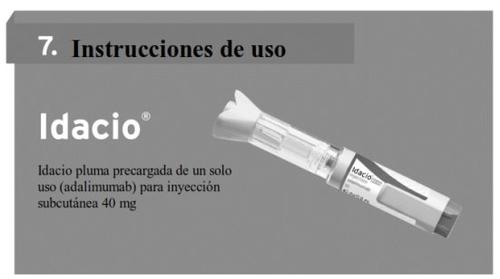
Note: Images are for illustrative purposes only
Read these instructions carefully before using your Idacio pre-filled pen.
Important Information
- Only use Idacio pre-filled pen if your healthcare professional has taught you to use it correctly.
- Idacio pre-filled pen comes as a single-use pre-filled pen to give a complete dose of adalimumab.
- Always inject using the technique your healthcare professional taught you.
- Children under 12 years old cannot inject themselves, and the injection must be performed by a trained adult.
- Keep the Idacio pre-filled pen out of the reach of children.
- Do not put your fingers into the safety guard opening.
- Do not use an Idacio pre-filled pen that has been frozen or exposed to direct sunlight.
- Talk to your healthcare professional if you have any questions or concerns.
Storage Information
- Keep the pre-filled pen in its original carton to protect it from light.
- Store the pre-filled pen in the refrigerator, between 2°C and 8°C.
- If necessary, for example, when traveling, a single pre-filled pen can be stored at room temperature for up to 14 days.
Familiarize yourself with your Idacio pre-filled pen
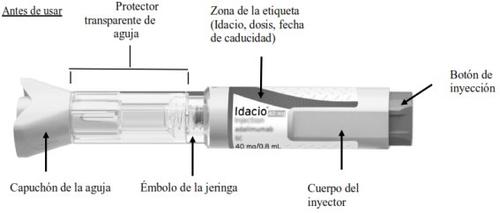
After Use

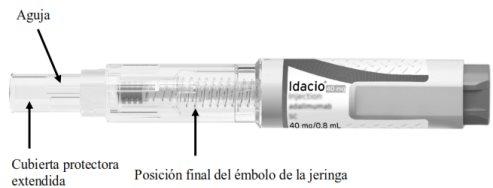
Step 1: Prepare your injection
Each Idacio pre-filled pen carton comes with two or six pre-filled pens.
1.1Prepare a flat and clean surface, such as a table or counter, in a well-lit area.
- You will also need (Figure A):
? an alcohol-impregnated wipe (included in the carton) ? a cotton ball or gauze, and
? a container for disposing of sharp objects.

Figure A
1.3Take the carton out of the refrigerator (Figure B).
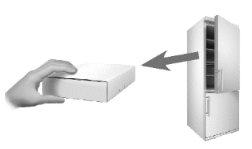
Figure B
1.4Check the expiration date on the side of the carton (Figure C).
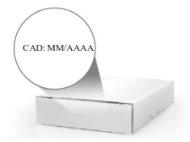
Figure C
Warning: Do not use if the expiration date has already passed
1.5Remove a pre-filled pen from the original packaging:
Place two fingers on the label area
Pull the pre-filled pen upwards and out of the packaging (Figure D).
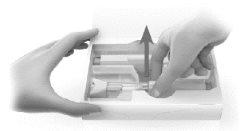
Figure D
Place it on a flat and clean surface.
1.6Put the remaining pre-filled pens back in their original carton in the refrigerator (Figure E).

Figure E
Refer to the storage information to learn how to store your unused pre-filled pen(s).
1.7Leave the pre-filled pen at room temperature for at least 30 minutes to allow the medication to reach room temperature. (Figure F).

Figure F
Injecting cold medication can be painful.
Warning: Do notheat the pen in any other way, such as in a microwave, hot water, or direct sunlight.
Warning: Do notremove the needle cap until you are ready to inject.
Step 2: Wash your hands
2.1Wash your hands with water and soap and dry them well. (Figure G).
Warning:Gloves will not replace the need to wash your hands.
Figure G |
|
Step 3: Check the pre-filled pen
3.1Check the transparent syringe casing to ensure:
- The liquid is clear, colorless, and free of particles (Figure H).
- The glass syringe is not cracked or broken (Figure H).
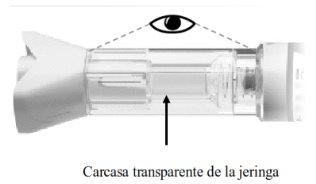
Figure H
Warning: Do notuse the pre-filled pen if the liquid contains particles, is cloudy, or is colored, has flakes, or shows any signs of damage.
If so, discard it in a container for disposing of sharp objects and contact your healthcare professional or pharmacist.
- Check the label to ensure:
- The name on the pre-filled pen is Idacio (Figure I).
- The expiration date on the pre-filled pen has not passed (Figure I).
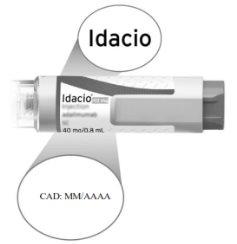
Figure I
Warning: Do notuse the pre-filled pen if the name on the label is not Idacio and/or if the expiration date on the label has passed.
If so, discard the pre-filled pen in a container for disposing of sharp objects and contact your healthcare professional or pharmacist.
Step 4: Choose the injection site
- Choose an injection site (Figure J) on:
- The front of the thighs.
- Abdomen (inject at least 5 centimeters away from the navel).
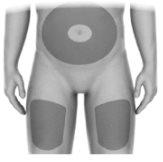
Figure J
4.2Choose a different site (at least 2.5 centimeters away from the last injection site) each time to reduce redness, irritation, or other skin problems.
Warning: Do notinject into an area that is painful (sensitive), bruised, red, hard, scarred, or has stretch marks.
Warning:If you have psoriasis, do notinject into any lesions or red, thickened, raised, or scaly areas.
Step 5: Clean the injection site
5.1Clean the skin at the injection site with an alcohol-impregnated wipe. (Figure K).
Warning: Do not blow or touch the injection site after cleaning.

Figure K
Step 6: Administer your injection
- Remove the needle protector
- Hold the pre-filled pen upwards and pull the needle protector straight off. (Figure L)
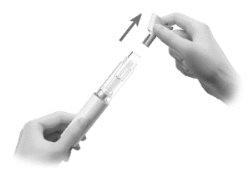
Figure L
You may see drops of liquid on the tip of the needle.
- Discard the needle protector.
Warning: Do nottwist the cap.
Warning: Do notrecap the pre-filled pen.
- Place the pre-filled pen
- Hold the pre-filled pen so that you can see the transparent syringe casing.
- Place your thumb on (without touching) the yellow injection button (Figure M).
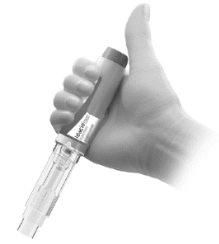
Figure M
- Place the pre-filled pen against your skin at a 90° angle (Figure N).
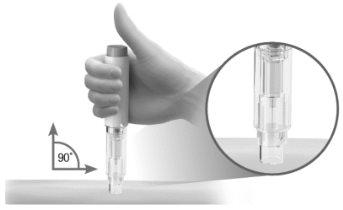
Figure NBefore injection
- Push and hold the pre-filled pen firmly against your skin until the safety guard is pressed all the way in. This will unlock the injection button (Figure O).
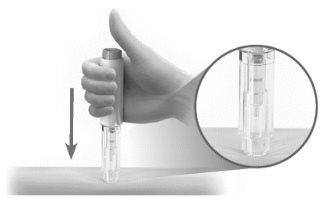
Figure O Before injection
- Administer the injection
- Press the injection button (Figure P).
- You will hear a click, which means the injection has started.
- Continue to hold the pre-filled pen firmly.
- WATCHthe syringe plunger to ensure it moves all the way down. (Figure P).
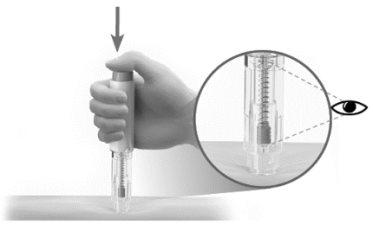
Figure PAfter injection
Warning: Do notlift the pre-filled pen off the skin until the plunger has moved all the way down and all the liquid has been injected.
- When the syringe plunger has moved all the way down and stopped moving, continue to hold it for 5 seconds.
- Lift the pre-filled pen off the skin (Figure Q).
The safety guard will slide down and lock into place to protect you from the needle. (Figure Q).
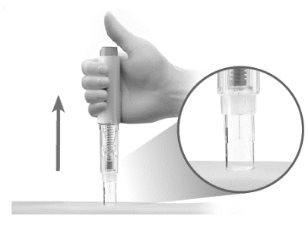
Figure Q
Warning: Contact your doctor or pharmacist if you have any problems.
6.4If there is blood or liquid on the skin, treat the injection site by gently pressing a cotton ball or gauze on the site (Figure R).

Figure R
Step 7: Dispose of your pre-filled pen
7.1Dispose of your used pre-filled pen in a container for disposing of sharp objects immediately after use (Figure S).
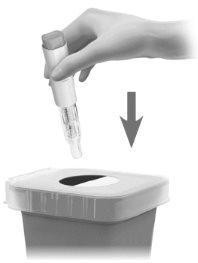
Figure S
Warning:Keep the container for disposing of sharp objects out of the reach of children.
Warning:Do not throw the pre-filled pen in the household trash.
If you do not have a container for disposing of sharp objects, you can use a household container that is:
- Made of sturdy plastic;
- Can be closed with a tight-fitting, puncture-resistant lid; this will prevent the sharp objects from coming out.
- Upright and stable during use,
- Leak-resistant and
- Properly labeled to warn of the presence of hazardous waste inside the container.
7.2When your container for disposing of sharp objects is almost full, you will need to follow local guidelines for the proper disposal of the container.
Do notrecycle your used container for disposing of sharp objects.
Step 8: Record your injection
8.1To help you remember when and where you should give your next injection, you should keep a record of the dates and injection sites used for your injections (Figure T).

Figure T
- Country of registration
- Active substance
- Prescription requiredYes
- Manufacturer
- CompositionFOSFATO DISODICO DIHIDRATADO HIDROGENADO (1.2 mg mg), DIHIDROGENOFOSFATO DE SODIO DIHIDRATO (0.7 mg mg), MANITOL (E-421) (9.6 mg mg), POLISORBATO 80 (0.8 mg mg), CLORURO DE SODIO (4.9 mg mg), CITRATO DE SODIO (E-331) (0.3 mg mg), HIDROXIDO DE SODIO (E 524) (csp pH mg)
- This information is for reference only and does not constitute medical advice. Always consult a licensed doctor before taking any medication. Oladoctor is not responsible for medical decisions based on this content.
- Alternatives to IDACIO 40 mg SOLUTION FOR INJECTION IN PRE-FILLED PENDosage form: INJECTABLE, 20 mgActive substance: adalimumabManufacturer: Amgen Europe B.V.Prescription requiredDosage form: INJECTABLE, 20 mgActive substance: adalimumabManufacturer: Amgen Europe B.V.Prescription requiredDosage form: INJECTABLE, 40 mgActive substance: adalimumabManufacturer: Amgen Europe B.V.Prescription required





